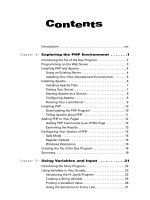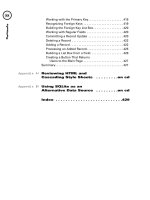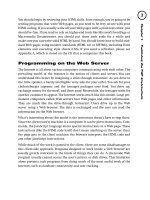PHP 5/MySQL Programming- P21 pot
Bạn đang xem bản rút gọn của tài liệu. Xem và tải ngay bản đầy đủ của tài liệu tại đây (134.55 KB, 5 trang )
<html>
<head>
<title>This Old Man</title>
</head>
<body>
<h1>This Old Man</h1>
<h3>Demonstrates use of functions</h3>
<?
verse1();
chorus();
verse2();
chorus();
function verse1(){
print <<<HERE
This old man, he played 1<br>
He played knick-knack on my thumb<br><br>
HERE;
} // end verse1
function verse2(){
print <<<HERE
78
P
H
P
5
/M
y
S
Q
L
P
r
o
g
r
a
m
m
i
n
g
f
o
r
t
h
e
A
b
s
o
l
u
t
e
B
e
g
i
n
n
e
r
FIGURE 3.14
This song has a
straightforward
pattern: verse,
chorus, verse,
chorus.
This old man, he played 2<br>
He played knick-knack on my shoe<br><br>
HERE;
} // end verse1
function chorus(){
print <<<HERE
with a knick-knack<br>
paddy-whack<br>
give a dog a bone<br>
this old man came rolling home<br>
<br><br>
HERE;
} // end chorus
?>
</body>
</html>
Careful examination of this code shows how it works. The main part of the pro-
gram is extremely simple:
verse1();
chorus();
verse2();
chorus();
Creating New Functions
The This Old Man code appears to have some new PHP functions. I called the
verse1() function, then the chorus() function, and so on. These new functions
weren’t shipped with PHP. Instead, I made them as part of the page. You can take
a set of instructions and store them with a name. This essentially builds a new
temporary command in PHP, so you can combine simple commands to do complex
things.
Building a function is simple. Use the keyword
function followed by the func-
tion’s name and a set of parentheses. Keep the parentheses empty for now; you
learn how to use this feature in the next section. Use a pair of braces (
{}) to com-
bine a series of code lines into one function. Don’t forget the right brace (
}) to
end the function definition. It’s smart to indent everything between the begin-
ning and end of a function.
79
C
h
a
p
t
e
r
3
C
o
n
t
r
o
l
l
i
n
g
Y
o
u
r
C
o
d
e
w
i
t
h
C
o
n
d
i
t
i
o
n
s
a
n
d
F
u
n
c
t
i
o
n
s
80
P
H
P
5
/M
y
S
Q
L
P
r
o
g
r
a
m
m
i
n
g
f
o
r
t
h
e
A
b
s
o
l
u
t
e
B
e
g
i
n
n
e
r
When you look at my code, you note there’s one line I never indent: the HERE token
used for multi-line strings. The word HERE acts like a closing quotation mark and
must be all the way to the left side of the screen, so it can’t be indented.
You can use any function name you like. Careful, though: If you try to define
a function that already exists, you’re bound to get confused. PHP has a large number
of functions already built in. If you’re having strange problems with a function,
look at the Help to see if that function already exists.
The chorus() function is especially handy in this program because it can be
reused. It isn’t necessary to rewrite the code for the chorus each time, when you
can simply call a function instead.
Using Parameters and Function Values
Functions are meant to be self-contained. This is good because the entire program
can be too complex to understand. If you break the complex program into smaller
functions, each function can be set up to work independently. When you work
inside a function, you don’t have to worry about anything outside the function. If
you create a variable inside a function, that variable dies as soon as you leave the
function. This prevents many errors that can otherwise creep into your code.
The bad side of functions being so self-contained is evident when you want them
to work with data from the outside. You can accomplish this a couple of ways.
• Send a
parameter
to a function, which allows you to determine one or
more values sent to the function as it starts.
• Give a function a
return
value.
The
param program shown in Figure 3.15 illustrates another form of the “This Old
Man” song. Although again the user might be unaware, some important differences
exist between this more sophisticated program and the first
This Old Man program.
Examining the Param.php Program
Notice that the output of Figure 3.15 is longer than that of 3.14, but the code that
generates this longer output is shorter.
<html>
<head>
<title>Param Old Man</title>
</head>
TRAP
TRICK
81
C
h
a
p
t
e
r
3
C
o
n
t
r
o
l
l
i
n
g
Y
o
u
r
C
o
d
e
w
i
t
h
C
o
n
d
i
t
i
o
n
s
a
n
d
F
u
n
c
t
i
o
n
s
<body>
<h1>Param Old Man </h1>
<h3>Demonstrates use of function parameters</h3>
<?
print verse(1);
print chorus();
print verse(2);
print chorus();
print verse(3);
print chorus();
print verse(4);
print chorus();
function verse($stanza){
switch ($stanza){
case 1:
$place = “thumb”;
break;
case 2:
$place = “shoe”;
break;
FIGURE 3.15
While the output
looks similar to
Figure 3.14, the
program that
produced this page
is much more
efficient.
case 3:
$place = “knee”;
break;
case 4:
$place = “door”;
break;
default:
$place = “I don’t know where”;
} // end switch
$output = <<<HERE
This old man, he played $stanza<br>
He played knick-knack on my $place<br><br>
HERE;
return $output;
} // end verse
function chorus(){
$output = <<<HERE
with a knick-knack<br>
paddy-whack<br>
give a dog a bone<br>
this old man came rolling home<br>
<br><br>
HERE;
return $output;
} // end chorus
?>
</body>
</html>
Looking at Encapsulation in the Main Code Body
This code features a number of improvements over the previous version. First
look at the main body of the code, which looks like this:
print verse(1);
print chorus();
print verse(2);
print chorus();
82
P
H
P
5
/M
y
S
Q
L
P
r
o
g
r
a
m
m
i
n
g
f
o
r
t
h
e
A
b
s
o
l
u
t
e
B
e
g
i
n
n
e
r









